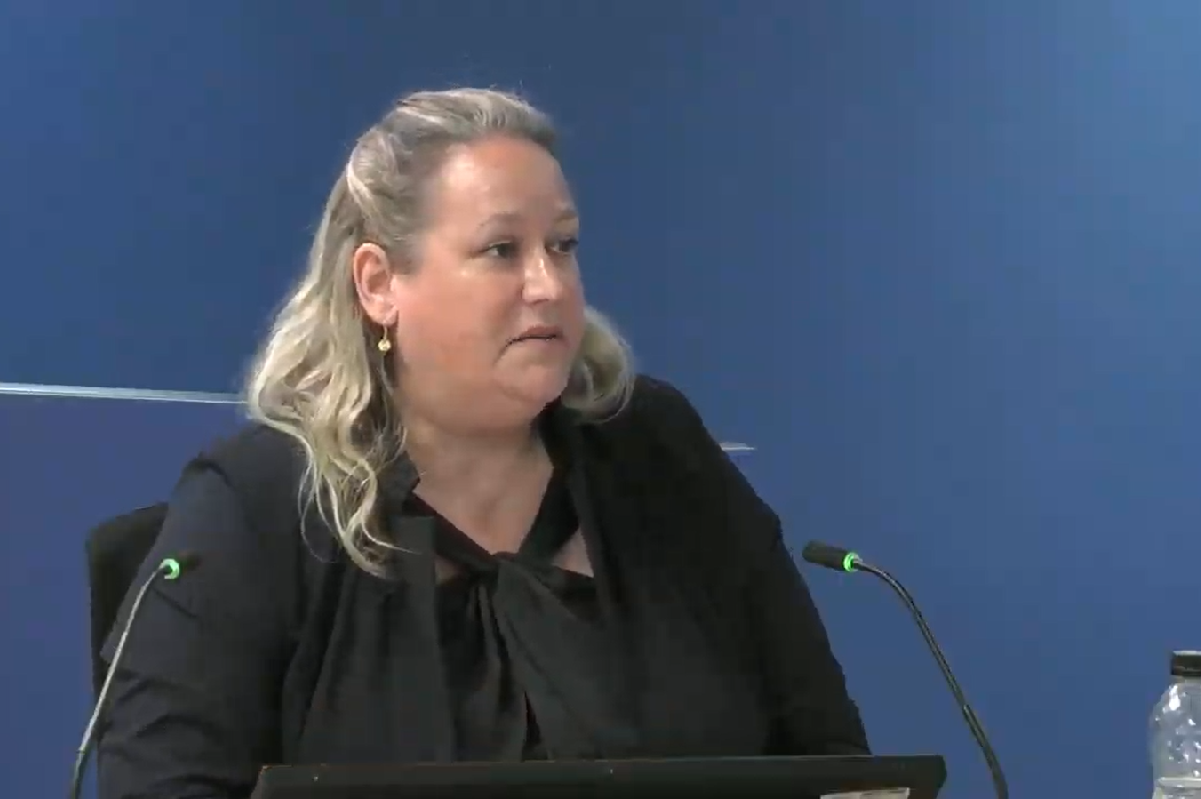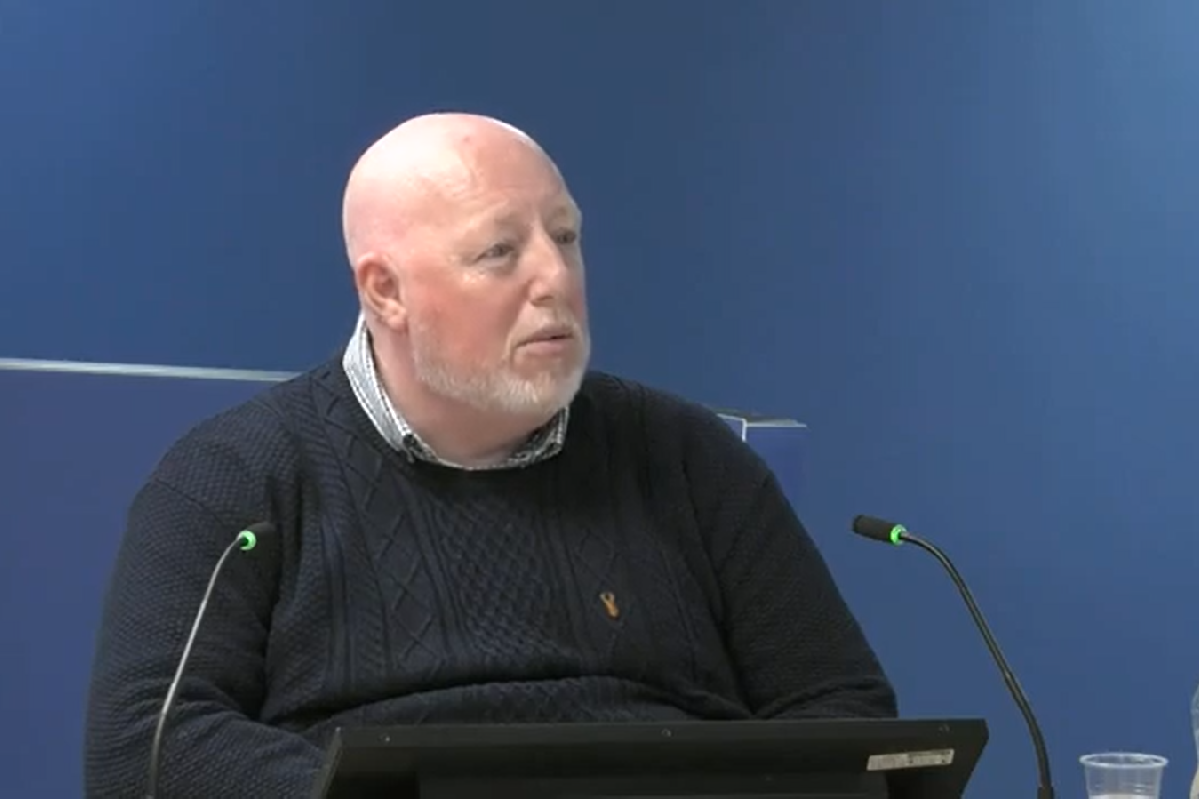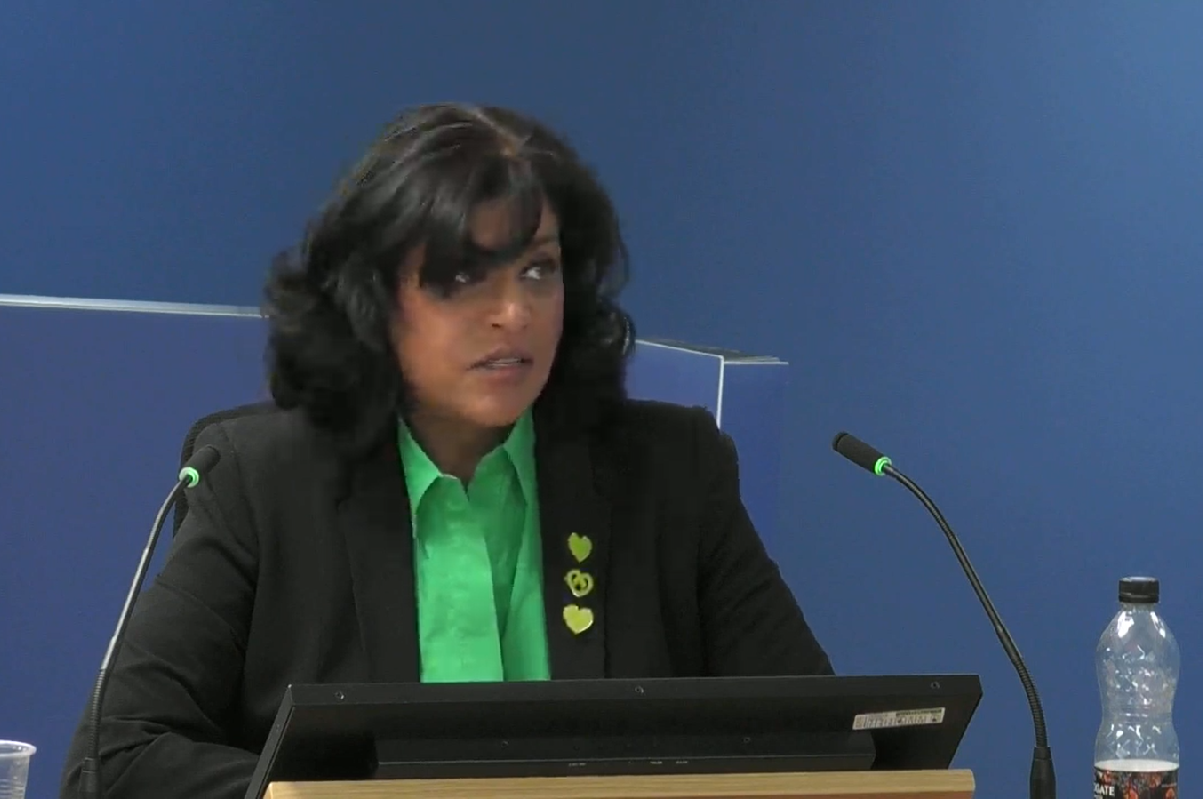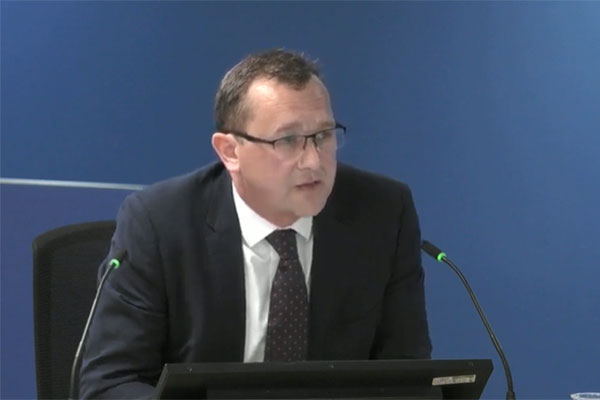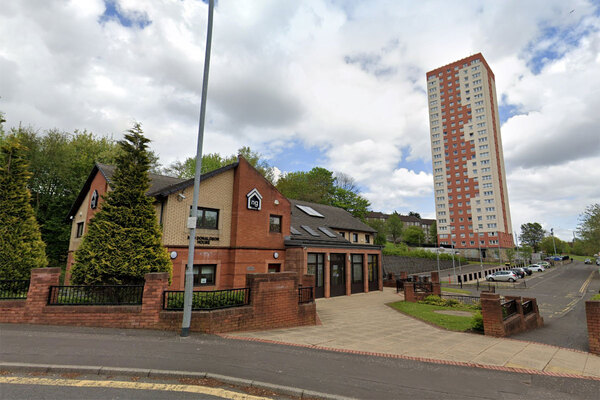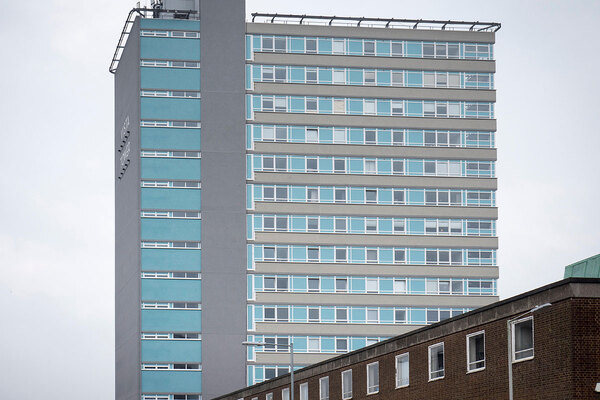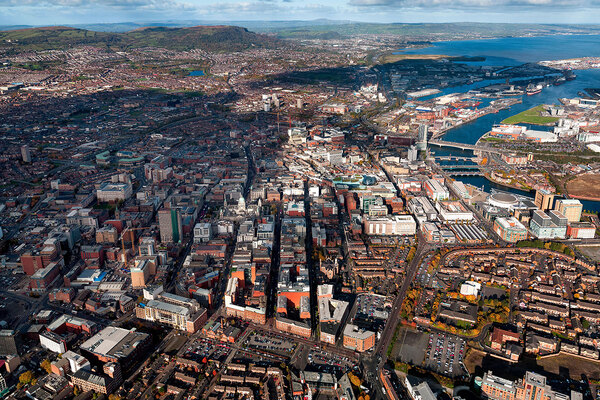Grenfell Tower Inquiry diary week 75: ‘It still shocks me to the core that that’s how we treat our citizens in this country’
This week the inquiry heard witnesses from the housing management body discuss their role in the aftermath of the Grenfell Tower fire, followed by a range of witnesses from other organisations which supported the response. Peter Apps and Grainne Cuffe report
The Kensington and Chelsea Tenant Management Organisation (KCTMO) was responsible for the management of the Royal Borough of Kensington and Chelsea’s (RBKC) 9,000 social homes.
Robert Black, former chief executive of KCTMO, talked down its responsibilities in the event of an emergency when he was called to give evidence on Tuesday.
“It was fully recognised that TMO did not have the resources to be able to respond to a major incident such as Grenfell Tower fire,” he said in his witness statement.
“In such circumstances, the RBKC emergency plan would operate as it did on the night of the fire from a very early stage.”
However, this is not actually what KCTMO’s emergency plan actually said. In fact, it explicitly stated that: “This plan can also be used for large-scale major events which would overwhelm the KCTMO’s ability to manage on its own, and which would involve the RBKC council resources.”
This planned conferred various responsibilities on KCTMO, including opening and managing a rest centre to cater for those affected, arranging roll calls of residents and identifying those with particular needs and vulnerabilities.
Following a prior large fire in another block, Adair Tower, in October 2015, KCTMO’s executive team noted a need for more involvement with RBKC on emergency planning “so that contact numbers and roles and responsibilities are known by all”.
Was anything ever done as a result? “I can’t recall, I’m afraid. It’s down for my PA to arrange, and I can’t recall if that happened,” said Mr Black.
“Is it correct that, despite this discussion… at the time of the Grenfell Tower fire, the TMO still lacked a clearly and formally defined role in the event that RBKC’s contingency planning systems were invoked?” asked Richard Millett QC, lead counsel to the inquiry.
“I would probably have to agree with that, yeah,” replied Mr Black.
‘So six days after the fire, there was still no clear communication or strategy?’
So what happened on the day of the fire itself? The inquiry saw minutes which showed Mr Black (pictured above) telling the council at 3pm on the day of the fire that KCTMO had “staff at every rest centre”.
But he does not appear to have provided an update about the condition of these centres, which the inquiry has already heard was chaotic and under-pressure, or the numbers of people attending.
“Why weren’t you in a position to feed in information about the numbers coming to the rest centres that your TMO staff were seeing?” asked Mr Millett.
“That information was coming from my staff to RBKC,” said Mr Black.
Another key issue was the fate of 845 residents who had been evacuated from low-rise buildings – known at the Walkways – which surrounded the tower.
These blocks were not involved in the fire, but they were damaged: flooded with water from hoses, doors broken in by police during the evacuation, and hot water, heating and cooking facilities out of action because their communal boiler was inside.
The buildings were also inside the police cordon, which meant residents could not return to their homes. Initially, RBKC was not willing to provide emergency accommodation to all of these residents. “Go and stay with friends and family in the first instance, but will house the old and vulnerable”, was the conclusion at a meeting attended by Mr Black.
But, oddly, this is not what his board was told, with their minutes recording “that hotel accommodation would be provided for all affected residents”.
“Why didn’t you clarify?” asked Mr Millett.
“I can’t recall. I mean, the only thing I can remember or I might suggest is that things had changed since then,” said Mr Black. He added that he was not at the meeting when this issue was discussed.
Residents from these homes who could not stay with friends and families were ultimately offered accommodation at the primary rest centre: the Westway Sports Centre.
But at a meeting the next morning, 15 June, the council noted that only 20 to 25 people had spent the night at the centre.
“Were you and others at the meeting concerned that these numbers were very low and ask the question, Well, where are the rest?’” asked Mr Millett.
“It was quite hard to get an understanding of the numbers and where people were, so…” said Mr Black.
The inquiry has previously heard that at least some of these residents had slept rough, unaware there were bedspaces at Westway.
Later that day, the council resolved to get residents back into their homes despite the condition, believing that they would not be able to provide emergency housing to all those affected.
“Was there any discussion about giving the residents of the Walkways a choice about whether to go back to their own homes which had no hot water or cooking facilities on the one hand, or to go to an emergency accommodation, a hotel perhaps, on the other?” asked Mr Millett.
“I’m not sure about that. I think the pressure was to get people to move back. I think that was a huge number of people, that if we could get people back into those homes, that would take the pressure off other aspects,” said Mr Black.
Meeting notes from 20 June suggested that confusion over what should be done continued to see residents given mixed messages, with the police telling some they had to “return at their own risk”.
“So six days after the fire, there was still no clear communication or strategy in respect of evacuated residents?” asked Mr Millett.
“It would appear that [way], yeah,” said Mr Black.
Teresa Brown, who served as director of housing at KCTMO between February 2014 and June 2018, also gave evidence about the Walkway residents this week.
Ms Brown said she had concerns about moving residents back into the homes so fast, but felt the decision had already been made by RBKC.
“I think they had made the decision. At this point in time, they had a huge amount of people in hotel accommodation in the middle of the summer and I think they had some very difficult decisions to make about where all these people were going to go,” she said.
‘All I can do is apologise. It’s very distressing I’m sure for everybody’
Among other issues, Ms Brown (pictured above) was asked about a list recording the status of Grenfell residents, which KCTMO was collecting and updating in the aftermath of the fire.
The list, which was on a spreadsheet being shared via KCTMO to the council and other organisations involved in the emergency response, noted those who were missing and those who were believed to be safe.
A version circulated at 12.21pm on 14 June listed Denis Murphy, the El-Wahabi family, Khadija Khalloufi and Saber Neda as ‘safe’. A later version also included 12-year-old Jessica Urbano Ramirez on the safe list.
All of these people had in fact died in the fire.
Ms Brown said she was unable to account for the mistake. “All I can do is apologise. It’s very distressing I’m sure for everybody, but I would look at later lists,” she said.
She accepted that this could have led to people being given the wrong information about their families.
Bereaved family members have previously told the inquiry the distress they felt after wrongly being told their relatives were safe.
Ms Brown was also asked about the system whereby KCTMO staff were recording information about residents on pieces of paper in the rest centres.
Ms Brown had gone to that rest centre to help when she arrived at the scene in the early hours of the morning.
KCTMO staff wrote information on “scraps of paper”, did not seem to have a system or to be capturing an accurate record of everyone that was arriving at, or leaving, the site and who they were looking for.
“We may have missed people despite our best endeavours… but I thought we had a process in place that was as efficient as it could be,” Ms Brown said.
‘Rumours that some [staff] are cleaning computer records’
Both Mr Black and Ms Brown were asked about emails sent between civil servants in the aftermath of the fire, which were scathing about KCTMO’s performance.
An email sent on 20 June, six days after the fire, by Sally Randall, then a senior civil servant in the Department for Communities and Local Government (DCLG), noted observations from Barbara Brownlee, then director of housing at neighbouring Westminster City Council, about KCTMO’s response.
It listed a series of damning conclusions, including that the organisation had “no leadership” and that “traumatised” staff were “drifting around”.
“Staff preoccupied with likelihood of criminal charges. No one is taking care of the staff,” it continued.
The email said that work on the Walkways “could be done in two to three weeks but will probably take two to three months given no leadership or urgency”.
“If this was an RP [a registered provider or housing association] the regulator would have had a new chief executive in on day two,” the said Ms Brownlee in the email.
Other emails said “the TMO remain terrible” and that politicians were “working very quickly… on how they can remove TMO from situation”.
Mr Black said he rejected the criticism. “It’s government acting as it does, trashing everybody else without actually giving them a chance to address it, and it was easy at that time to slag us off, as this does,” he said.
He added: “It suited their narrative to get rid of the TMO. So, you know, it’s bury bad news and bury it on the TMO.”
For her part, Ms Brown said: “What I saw… our staff were staff who were focused on getting on with the job and doing what they could to support people, and I don’t recall us being dithering or unable to act or cope.”
KCTMO was ultimately stripped of its responsibilities for housing management in August 2017, with the news announced to bereaved and survivors personally by then-prime minister Theresa May.
‘You were greeted with armed police’
As well as the KCTMO witnesses, the inquiry heard from various other organisations that worked on the response.
These included local charities the Clement James Centre and Rugby Portobello Trust, both of which opened their doors to the community in the aftermath of the fire.
Clement James opened its doors at around 2am and began offering support, including shelter and food, to those fleeing the tower.
As the incident progressed, the charity also began gathering information on spreadsheets on their laptops about who was coming through their doors.
“Had there been a team of officials, as I assumed there would be, then I guess we’d have just been asking them what we could do to assist them,” said Clare Richards (pictured above), chief executive of the centre. “But there weren’t a team of officials, so therefore it was important that we took on that role.”
She said that use of these laptops was offered to KCTMO staff who arrived at the centre, but “they always turned down these offers”. A member of KCTMO staff also confiscated their records and ordered them to stop collecting them as “only they should be collecting this information”.
Ms Richards also explained the lack of information on issues such as emergency housing. “I’m sure there were all sorts of marvellous things happening behind the scenes, but from the perspective of us on the ground at a rest centre, there was a total absence of any information whatsoever,” she said.
Clement James continued to offer support over the next few days, with residents who had been sent to hotels returning to the area to seek support or information. They raised a variety of concerns: a feeling of isolation and a lack of information, through to the lack of cooking facilities and trauma associated with being placed on upper floors.
Ms Richards also raised concerns about the Westway Sports Centre, which became the council’s main site for supporting residents.
“It was quite an intimidating experience to visit,” she said. “You were greeted with armed police, which, fortunately, we’re not too familiar with yet, and asked to wear a wristband and then all the different services were on different tables. It just didn’t have that kind of warm, safe space that I’m sure they wanted to achieve.”
Ms Richards was also involved in Ms May’s visit to the estate on 16 June. Ms Richards said they only received 15 minutes’ notice that the prime minister was coming and their main response was to ensure they could continue “providing a safe space” for affected members of the community “and not to have a sort of media circus” when Ms May arrived.
Ms Richards said the meeting finished after a few minutes when the sound of protestors outside became audible and “[Ms May’s] security team said that, actually, she needed to end the meeting”.
At the end of her evidence Ms Richards criticised the lack of communication from RBKC. “How do you have a situation where families have lost their children and they’re left for days without anybody official having a conversation with them about whether there was any chance that those children were alive? And I find that mind-blowing,” she said.
‘It still shocks me to the core that that’s how we treat our citizens in this country’
The inquiry also heard from Mark Simms (pictured above), chief executive of the charity that manages the Rugby Portobello Trust, a youth centre close to Grenfell Tower.
Mr Simms arrived at the youth club at around 7.30am on the morning, having travelled from Nottinghamshire when he heard about the fire. Around 100 people were in the centre by this point “in various states of confusion and distress”.
He said his initial focus was meeting basic needs until more help arrived, “making sure people had got stuff to eat… really simple things like making sure that the toilets were constantly cleaned and things like that”.
The charity also distributed around £80,000 in cash to survivors, many of whom had fled the tower with nothing and had seen all their possessions destroyed.
“We knew a lot of these people, they’re people from the local community, and so we took it on face value and trust,” Mr Simms said.
“Some people were really reluctant to take cash, and there was a lot of paranoia and there’s a lot of pride at stake. So we really had to build up those relationships to say, ‘Actually, we want you to have this, don’t struggle through the day with no shoes, if you need shoes, go and get some shoes.’”
He said the provision of cash rather than donated items provided some “dignity”. “We had a lot of donations and stuff that came in, if you’re a size 9.5 shoe and we’ve only got 8s and 10s, you’ve got no shoes,” he said.
“If somebody was a vegetarian or a vegan and we didn’t have a sandwich, then they could go and get one… If you smoke and you ain’t got fags, then you don’t want to be bumming that off someone else, so go and get yourself some cigarettes. It was just that simple thing.”
During the morning, the centre became a space exclusively for survivors. Mr Simms said the area was being overrun with “press, pop stars, politicians and volunteers from all over London” and he wanted a space where survivors had some privacy.
“We told everyone who came to RPT [Rugby Portobello Trust] on the first day that we would be there for them on the second day and we would try and find out what the longer-term plan was and help them with whatever they needed,” Mr Simms said in his witness statement.
“Did you ever find out what that longer-term plan was?” asked Zeenat Islam, junior counsel to inquiry.
“I’m still waiting to find out now,” Mr Simms said.
In the days after the fire, the club cancelled its normal activities and focused wholly on responding to the fire. Among other things, it organised transport to hotels and hospitals, structured clothing provision, a pop-up pharmacy and doctor’s practice, provision of smart phones and laptop, and a home pack from Dixons chain store which included items such as TVs, kettles and microwaves.
“In all the support you have described, did you receive any support from RBKC or later the London Gold response team to assist you?” asked Ms Islam.
“No,” replied Mr Simms. “We’re a youth organisation in North Kensington. We’re not an organisation that’s geared up to deliver emergency response stuff. So we would have been an ally to the borough rather than a leading actor, and we ended up being a leading actor.”
He added: “I remain incredulous that this happened in London in 2017, and people were left to their neighbours to provide care, comfort and shelter, in one of the richest boroughs in the country, in one of the richest cities in the world. It still shocks me to the core that that’s how we treat our citizens in this country.”
“Two named volunteers… report that some of the housing staff were heard telling victims to ‘fuck off’”
On Wednesday, the inquiry heard from Rupinder Hardy (pictured above), a local authority liaison officer from Ealing Council, who attended the Westway Sports Centre from 17 June to assist with the response.
Asked for her initial reaction to the centre, Ms Hardy said: “It was astounding. It was quite shocking. As we approached the leisure centre itself, there were a lot of people. We saw the Red Cross desks outside, taking names and handing out wristbands. There was the police cordon up, police vans… There was a lot of media as well.”
Immediately, she set about removing the police cordon and the vans and arranging for the centre to be cleaned up, with bins outside overflowing and a jumble of junk around the entrance.
Ms Hardy said that she arrived expecting a handover and a walk through of the site, but there appeared to be no one in charge or available to provide this information.
“There really wasn’t anybody,” she said. “It was just bizarre, if I’m honest.”
“I didn’t expect everything to be flowing like clockwork, but I did expect to see some rigour,” she added. “Something that I would recognise as, ‘Right OK, so this is the process, this is what you’re doing.’ I didn’t feel that at all.”
Ms Hardy then sent an email to her seniors telling them she had “assumed control” of the centre.
“Why did you make that decision?” asked counsel to the inquiry Dermot Keating.
“Because there was no leadership on the ground,” Ms Hardy said. “Without clear systems, it’s a free for all. We needed to build a structure pretty rapidly within the centre so we could focus on the bereaved and the survivors.”
Shortly after 2.30pm, she held a meeting which included all of the volunteers at the centre – it was the first time they had been invited into an official meeting.
They raised numerous issues about the response, including that hundreds of people were in hotels with families separated, police tape outside the centre was putting people off from attending, body bags were visible outside, and some of the food being delivered was not halal.
Ms Hardy said volunteers also warned that residents were not being “treated with the respect that people should be afforded”.
“Staff were being rude to them and they just weren’t getting the type of support and response that they expected, the level of care that they expected,” she said.
The inquiry was shown a ‘situation report’ from the meeting, recorded by another staff member from Ealing Council.
“The volunteers raised a number of issues about rude and inconsiderate housing officers from RBKC and stated that housing officers continue to be problematic,” the report said.
“Two named volunteers… report that some of the housing staff were heard telling victims to ‘fuck off’.”
“Were you able… to observe or hear such behaviour?” asked Mr Keating.
“I personally didn’t,” Ms Hardy replied. “But that’s not to say it didn’t happen, because I spoke to several people, both volunteers and on the Ealing side, who told me that it did… It was absolutely uncalled for. I’m sorry I did not witness it. I wish I had because I would have taken more direct action.”
The inquiry also heard from Michael Adamson, chief executive of the British Red Cross. Among many other issues, he was asked about a problem which emerged with the volume of physical items donated to the survivors from around the country.
“Did you consider that the volume of physical donations, perversely, had an adverse impact on the emergency response?” asked Mr Keating.
“Yes, and this is very common in emergencies of a sudden onset nature, where people want to show kindness by giving something,” Mr Adamson said.
“The challenge is that something that somebody wants to give may not be what the person who’s affected by the emergency needs or wants.”
He said that at Grenfell, “there were nearly 200 tonnes of donated goods of varying quality” and that this “overwhelmed” RBKC, with responders spending time sorting through items.
Mr Adamson agreed when asked if cash donations allow “dignity and choice” by giving those affected “some autonomy over their circumstances”.
‘And that the absence of it was a serious failing?’
Finally this week, the inquiry heard the opening of evidence from John Hetherington (pictured above), who at the time of the Grenfell Tower fire was deputy head of the London Resilience Group (LRG).
He was questioned throughout the morning about the structure of London Resilience, an umbrella term for a host of groups that have duties in response to an emergency.
One of those groups, the London Risk Advisory Group (LRAG), was made up of members from a number of category one and two responders, such as police, local authorities and utilities. It maintained the London Risk Register (LRR), a document that provides a list of the principal risks that may affect the capital as a whole.
But a residential high-rise fire was not named as a major risk in the most recent version of the document at the time of Grenfell Tower fire.
Mr Millett said the closest thing to a fire risk the inquiry could find in the document was a wildfire or forest fire.
Mr Hetherington accepted that “in hindsight” it was a “serious failing” that a tower block fire was not considered a risk, despite two major fires occurring in blocks since 2009.
He repeated what has been heard by the inquiry numerous times: that it was accepted at the time that the building regulations were strong enough to prevent a large-scale fire happening.
Mr Hetherington said it now has been reflected in the 2019 version.
The inquiry was also shown an individual risk assessment, which provides more granular data on specific risks, that had no reference to any major London fire.
The description of a ‘complex built environment’ in the document included places such as sports stadiums and large educational settings, but failed to include dense housing or tower blocks.
Mr Millett said: “Did anyone from the Department for Communities and Local Government ever give you or your colleagues on the LRG any reason to think that a major tower block fire as a result of the presence of combustible materials in the cladding structure did not present a risk that you needed to consider for the purposes of the LRR?”
“No,” replied Mr Hetherington.
The inquiry continues, with Mr Hetherington’s evidence to carry on next week.
Sign up for our weekly Grenfell Inquiry newsletter
Each week we send out a newsletter rounding up the key news from the Grenfell Inquiry, along with the headlines from the week
Already have an account? Click here to manage your newsletters
Grenfell Tower Inquiry phase two: weekly diaries
Module one: the refurbishment
Week one: A vivid picture of a broken industry
After a week of damning revelations at the opening of phase two of the Grenfell Tower Inquiry, Peter Apps recaps the key points
Click here to read the full story
Week two: What is the significance of the immunity application?
Sir Martin Moore-Bick has written to the attorney general requesting protection for those set to give evidence at the Grenfell Tower Inquiry. Peter Apps explains what the move means
Click here to read the full story
Week three: Architects of misfortune
This week saw the lead architects for the Grenfell Tower refurbishment give evidence to the inquiry. Peter Apps runs through the key points
Click here to read the full story
Week four: ‘I didn’t have any perception that it was the monster it’s become’
The architects continued to give evidence this week, outlining a lack of understanding of the fire risk posed by the cladding materials and its design. Nathaniel Barker reports
Click here to read the full story
Week five: ‘No adverse effect in relation to external fire spread’
As the Grenfell Tower Inquiry returns from its long absence, Peter Apps recaps the key points from a week of important evidence from the fire consultants to the refurbishment
Click here to read the full story
Week six: ‘I can’t recall any instance where I discussed the materials with building control’
Nathaniel Barker summarises what we learned from fire engineers Exova, architects Studio E and the early evidence from contractor Rydon
Click here to read the full story
Week seven: ‘I do not think I have ever worked with a contractor operating with this level of nonchalance’
Two key witnesses from contractor Rydon gave evidence this week. Peter Apps recaps some of the key points from a revealing week of evidence
Click here to read the full story
Week eight: ‘It haunts me that it wasn't challenged’
Four witnesses from contractor Rydon gave evidence this week. Lucie Heath recaps what we learned on the last week of evidence before the inquiry breaks for five weeks
Click here to read the full story
Week nine: ‘All I can say is you will be taken out for a very nice meal very soon’
This week the inquiry heard evidence from witnesses at Harley Facades, the sub-contractor responsible for Grenfell Tower’s cladding. Peter Apps recaps the key points
Click here to read the full story
Week 10: ‘As we all know, ACM will be gone rather quickly in a fire!’
As the Grenfell Tower Inquiry entered its 10th week, Jack Simpson recaps the key points from a week of important evidence from the refurbishment’s cladding contractor
Click here to read the full story
Week 11: ‘Did you get the impression Grenfell Tower was a guinea pig for this insulation?’
With witnesses from the cladding subcontractor, the firm which cut the deadly panels to shape and the clerk of works which inspected the job giving evidence this was week full of revelations. Peter Apps recaps the key points
Click here to read the full story
Week 12: ‘Would you accept that was a serious failing on your part?’
With the surveyor who inspected Grenfell Tower for compliance giving evidence, this was a crucial week from the inquiry. Dominic Brady and Peter Apps report
Click here to read the full story
Week 13: ‘Value for money is to be regarded as the key driver for this project’
With consultants to Kensington & Chelsea Tenant Management Organisation (KCTMO) giving evidence, attention at the Grenfell Tower Inquiry turned for this first time to the actions of the TMO and the council. Peter Apps reports
Click here to read the full story
Week 14: ‘Did it not occur to you at this point that your budget was simply too low?’
This week, for the first time in phase two, the inquiry heard from Kensington & Chelsea Tenant Management Organisation, the landlord that oversaw the fatal refurbishment of Grenfell Tower. Lucie Heath reports
Click here to read the full story
Week 15: ‘Have you ever informed the police that you destroyed documents relevant to their investigation?’
Witnesses from the Kensington and Chelsea Tenant Management Organisation (KCTMO) gave evidence for a second week, which began with a shocking revelation about withheld and destroyed evidence. Peter Apps recaps
Click here to read the full story
Week 16: ‘I conclude this was very serious evidence of professional negligence’
This week saw members of Kensington & Chelsea Tenant Management Organisation finish giving evidence, before the inquiry’s expert witnesses took the stand to make some highly critical assessments of the work they had seen before and during the refurbishment of Grenfell Tower. Jack Simpson recaps
Click here to read the full story
Grenfell Tower: a timeline of the refurbishment
Following the conclusion of module one of the Grenfell Inquiry’s second phase, Peter Apps presents a timeline of the key moments during the fatal refurbishment of the west London tower block
Click here to read the full story
Module two: the cladding products
Week 17: ‘It’s hard to make a note about this because we are not clean’
The start of the second module of the Grenfell Tower Inquiry phase two came with some huge revelations about the companies that sold the products used in the cladding system. Peter Apps reports
Click here to read the full story
Week 18: ‘It was just reckless optimism wasn't it?’
As the inquiry began cross-examining witnesses for the second module of its phase two work, the picture surrounding just how Grenfell Tower ended up wrapped in such dangerous materials became a little clearer. Nathaniel Barker was keeping an eye on proceedings
Click here to read the full story
Week 19: ‘And that was intentional, deliberate, dishonest?’
The Grenfell Tower Inquiry this week heard the shocking story of how the insulation manufacturer “manipulated” official testing and marketed its product “dishonestly”. Peter Apps tells the story
Click here to read the full story
Week 20: ‘We were outed by a consultant who we then had to fabricate a story to’
This week the inquiry investigated the actions of Kingspan – the manufacturer of one of the insulation products used in the tower’s cladding system. Dominic Brady reports
Click here to read the full story
Week 21: ‘It’s there in black and white isn't it? We see a complete absence of any consideration of life safety’
The story of insulation giant Kingspan’s testing and marketing of its combustible insulation for high rises was unpacked in minute detail this week. Peter Apps reports
Click here to read the full story
Week 22: ‘All we do is lie in here’
In the third week of evidence from insulation giant Kingspan, the inquiry continued to uncover shocking details about the firm’s behaviour both before and after the Grenfell Tower fire. Lucie Heath reports
Click here to read the full story
Week 23: ‘That would have come as an earthquake to you at the time, would it not?’
This week the inquiry took its deepest dive yet into the inner workings of the cladding manufacturer whose product has been blamed for the terrible spread of fire up Grenfell Tower. Nathaniel Barker reports
Click here to read the full story
Week 24: ‘Do you accept that Test 5B was Arconic's deadly secret’
The president of the firm that made and sold the cladding panels installed on Grenfell Tower was asked to account for the apparent concealment of “disastrous” fire tests on the product this week. Peter Apps reports
Click here to read the full story
Week 25: ‘This is quite an incredible list of omissions and missed instances, isn’t it?’
This week the Grenfell Tower Inquiry heard its first witnesses from the Building Research Establishment (BRE) - the testing house which carried out key fire tests on the Kingspan and Celotex insulation products which were later used on Grenfell Tower. Peter Apps reports.
Click here to read the full story
Week 26: 'You were taking an enormous risk, weren't you?'
Week 26 at the Grenfell Tower Inquiry was a key moment in understanding how dangerous products used on the tower came to be accepted by industry professionals. Dominic Brady reports
Click here to read the full story
Week 27: ‘What will happen if one building made out [of] PE core is in fire and will kill 60 to 70 persons?’
The most explosive evidence this week at the Grenfell Tower Inquiry came from those who did not attend, as the evidence which would have been presented to Arconic witnesses was displayed in their absence. Peter Apps reports
Click here to read the full story
Week 28: ‘This is a serious safety matter’
This week the Grenfell Tower Inquiry zeroed in on the British Board of Agrément, the body that produced “misleading” certificates which inspired trust in both the cladding and insulation used on the tower. Lucie Heath reports
Click here to read the full story
Week 29: ‘Is it true that Kingspan’s position… was to do its best to ensure that science was secretly perverted for financial gain?’
The final week in this section of the Grenfell Tower Inquiry primarily examined the attempts by insulation manufacturer Kingspan to lobby government after the fire. Peter Apps reports
Click here to read the full story
How the products used in Grenfell Tower's cladding system were tested and sold
As the section of the Grenfell Tower Inquiry examining how the products used in the cladding system were tested, marketed and sold comes to a close, Peter Apps summarises what we have learned about each of the products included in the system
Click here to read the full story
Module Three: the management of the tower
Week 30: ‘There is certainly a high probability that in the event of a fire the whole building can become an inferno’
The focus of the inquiry shifted this week to the actions of the social housing providers responsible for maintaining Grenfell Tower. Pete Apps recaps what we learned
Click here to read the full story
Week 31: ‘If we cannot get out people will die’
This week saw the former residents of Grenfell Tower enter the witness box to tell of their experiences attempting to raise complaints with the council and its managing agent. Pete Apps reports
Click here to read the full story
Week 32: ‘Let's hope our luck holds and there isn't a fire’
This week saw the return of the landlord of Grenfell Tower, Kensington and Chelsea Tenant Management Organisation (KCTMO), as senior staff members attempted to explain how vital fire safety protections at the block were allowed to fall into disrepair. Lucie Heath reports
Click here to read the full story
Week 33: ‘Isn't that a serious gap in the scope of a policy meant to safeguard vulnerable people?’
A slightly disjointed week at the Grenfell Tower inquiry saw further evidence from staff at building manager Kensington and Chelsea Tenant Management Organisation (KCTMO) interspersed with the views of a cladding expert. Peter Apps reports
Click here to read the full story
Week 34: ‘Some members of the community are doing their best to spread false information’
Jack Simpson covers all the major revelations from the past week of evidence at the Grenfell Inquiry, including evidence from Laura Johnson, director of housing at the Royal Borough of Kensington and Chelsea.
Click here to read the full story
Week 35: ‘I really didn’t like the champagne’
This week the Grenfell Tower Inquiry saw council witnesses, including former deputy leader Rock Feilding-Mellen and leader Nicholas Paget-Brown, questioned about their role in the story for the first time. Peter Apps reports
Click here to read the full story
Week 36: ‘Is that not a very incurious approach for a fire risk assessor?’
This week the Grenfell Tower Inquiry scrutinised the work of Carl Stokes, the man hired to carry out fire risk assessments for the block. Nathaniel Barker reports
Click here to read the full story
Week 37: ‘In giving that advice, weren’t you acting beyond your knowledge and expertise?’
A curtailed week at the Grenfell Tower Inquiry saw fire risk assessor Carl Stokes grilled over advice he gave regarding the tower’s cladding. Peter Apps reports
Click here to read the full story
Week 38: ‘Well it’s a bit more than that, isn’t it. He’s suggesting that you tell the LFB a lie’
The inquiry heard the mammoth cross-examination of KCTMO’s health and safety manager Janice Wray this week. Peter Apps reports
Click here to read the full story
Week 39: ‘What you said there was a grotesque understatement’
This week the inquiry continued to hear from former employees of Kensington and Chelsea Tenant Management Organisation, as well as two employees from the London Fire Brigade. Lucie Heath reports
Click here to read the full story
Week 40: ‘An exercise in concealment and half-truth’
Former KCTMO chief executive Robert Black gave his evidence to the inquiry this week and was asked to account for the various failures described over the previous six weeks. Peter Apps and Nathaniel Barker report.
Click here to read the full story
Week 41: ‘We should do nothing. This is not the sort of website we should be responding to’
This week saw the return of Robert Black, chief executive of Kensington and Chelsea Tenant Management Organisation (KCTMO), before the inquiry turned its attention to the defective smoke control system in the tower. Dominic Brady reports
Click here to read the full story
Week 42:‘They would leak as much as they leaked. They were what they were’
The Grenfell Tower Inquiry continued its in-depth investigation of the tower’s non-compliant smoke control system this week, with evidence from the various contractors involved in delivering it. Pete Apps reports
Click here to read the full story
Week 43:‘Contractors at the time were not generally aware of the importance of leaving holes unsealed’
This week the inquiry focused on two of the more overlooked areas of the Grenfell Tower fire, with evidence focusing on the gas pipelines and lifts within the west London block. It was a packed week, with five witnesses giving evidence. Jack Simpson reports
Click here to read the full story
Week 44:‘I've never seen a fully compliant firefighting lift in any local authority building, to this day actually’
This week the inquiry turn the focus onto the building’s defective lifts, with evidence from an expert, contractors who worked on them and a former engineer at KCTMO. Pete Apps reports.
Click here to read the full story
Week 45: ‘Don’t you find all this rather a surprising debate, given that the Equality Act was passed in 2010?’
The inquiry heard from expert witness Colin Todd this week, who gave his views about the work of risk assessor Carl Stokes as well as answered questions about his own guidance. Peter Apps and Nathaniel Barker report
Click here to read the full story
Week 46: ‘I think I've been very, very clear that is completely wrong’
This week the inquiry heard further expert evidence about fire risk assessor Carl Stokes’ actions, as the section of its work covering the management and maintenance of the tower concluded. Peter Apps reports
Click here to read the full story
Six key failures in the way Grenfell Tower was managed before the fire
Peter Apps recaps some of what we have learned about the actions of the Royal Borough of Kensington and Chelsea (RBKC) and Kensington and Chelsea Tenant Management Organisation (KCTMO) in the years before the fire.
Module one and two closing statements
Week 47: ‘An unedifying spectacle’
After a week of closing statements from the core participants involved in modules one and two, Lucie Heath recaps the key arguments of each group
Click here to read the full story
Module five: the fire brigade
Week 48: ‘They knew, and lives could and should have been saved’
The phase of the Grenfell Tower Inquiry examining the actions of the London Fire Brigade in the years before the fire kicked off this week with some major revelations. Peter Apps reports
Click here to read the full story
Week 49: ‘I'm not sure we've always taken every opportunity to learn as an organisation’
How the London Fire Brigade acted upon lessons from incidents in the years before the Grenfell Tower disaster came under the microscope this week at the public inquiry. Nathaniel Barker reports
Click here to read the full story
Week 50: ‘There is a culture in LFB that is very conservative. I think there is great comfort in what is familiar’
This week the inquiry heard how the London Fire Brigade (LFB) elected not to issue warnings about dangerous cladding before Grenfell and a detailed examination of its policy for checking high risk buildings. Pete Apps reports.
Click here to read the full story
Week 51:‘We teach firefighters to expect building failure’
An unusually brief week of evidence at the Grenfell Tower Inquiry explored how a fire service neighbouring London was taking a different approach to tackling blazes in high rises. Nathaniel Barker reports
Click here to read the full story
Week 52: ‘I actually think that there is a measure of incompetence at all levels’
Expert evidence concluded the current section of the inquiry with some stinging criticism of the London Fire Brigade (LFB). Pete Apps and Grainne Cuffe report.
Click here to read the full story
Module six: fire services
Week 53: ‘They make for chilling reading and harrowing listening’
The inquiry’s investigation into central government began this week with lawyers setting out their view on how and why firefighting policies failed. Peter Apps and Lucie Heath report
Click here to read the full story
Week 54: ‘Our consideration of evacuation at this time was something of a blind spot’
The development of policy on ‘stay put’, both nationally and for London, occupied the attention of the inquiry this week. Peter Apps reports
Click here to read the full story
Week 55: ‘My review is pretty scathing!’
In a week that included the 200th day of evidence in phase two of the inquiry, attention turned to the London Fire Brigade’s control room. Lucie Heath reports
Click here to read the full story
Week 56: ‘Why didn't we thump the table harder’
This week, the control room at the London Fire Brigade was examined further – both before and after the fire. Pete Apps and Lucie Heath report
Click here to read the full story
Week 57: ‘It was worse than slow, it was sluggish’
Former London Fire Brigade (LFB) commissioner Dany Cotton was the star witness this week, as the inquiry continued to delve into the brigade’s knowledge and training before the Grenfell Tower fire. Jack Simpson, Grainne Cuffe and Pete Apps report
Click here to read the full story
Week 58: ‘I don't think we deserve to ask for trust until we demonstrate different outcomes’
A current and former commissioner of the London Fire Brigade (LFB) wrapped up the inquiry’s investigation into the actions of the brigade before the fire. Grainne Cuffe and Peter Apps report.
Module six: testing and government
One of the major scandals of our time: key revelations as the Grenfell Tower Inquiry turns to government
The government was accused of “covering up” the risks of dangerous cladding as its “unbridled passion for deregulation” left it a “junior party” to the construction industry as the latest phase of the public inquiry opened today. Peter Apps summarises some of the main points
Click here to read the full story
Week 59: ‘Recent tests have apparently shown it continued to burn for 20 minutes after the flame was taken away’
After shocking opening statements, the Grenfell Tower Inquiry turned its attention to the work of Local Authority Building Control. Pete Apps reports
Click here to read the full story
Week 60: ‘You could have an exact repeat of the Dubai fire in any number of buildings in London’
The Grenfell Tower Inquiry turned its attention to the work of the National House Building Council this week, with shocking revelations about the extent of the warnings issued to central government before the fire. Peter Apps reports
Click here to read the full story
Week 61: ‘Mistakes are meant for learning, not repeating’
In the first hearings of the new year, the Grenfell Tower Inquiry heard closing statements from the firefighting section of phase two. Lucie Heath reports
Click here to read the full story
Week 62: Did it ever occur to you that this act of collaboration was, in one sense, corrupting?
The Grenfell Tower Inquiry returned to the work of the National House Building Council (NHBC) this week, with a new shocking revelation about the government’s actions in the immediate aftermath of the fire. Peter Apps reports
Click here to read the full story
Week 63: ‘It came after the general move to deregulation. So more regulation was not welcome’
The government’s focus on deregulation before the Grenfell Tower fire was placed in the spotlight this week with a series of shocking revelations about its failure to amend fire safety guidance. Pete Apps and Grainne Cuffe report
Click here to read the full story
Week 64: ‘I didn’t think ACM would be suitable for use in any high-rise buildings. I don’t think anyone did’
This week, the Building Research Establishment’s Dr Sarah Colwell gave more than three days of evidence, with some huge revelations about what was known about the dangers of aluminium composite material years before the fire and the mass confusion over the government’s building regulations. Peter Apps and Jack Simpson report
Click here to read the full story
Week 65: ‘Unless the government does something now about ACM panels, people will die’
Further evidence from the Building Research Establishment and the first government witnesses added new depth to our understanding of how warnings were missed before the Grenfell Tower fire. Peter Apps reports
Click here to read the full story
Week 66: ‘Was there a cover-up?’
The latest evidence from the Grenfell Tower Inquiry tracked the government’s failure to act on fire safety warnings right up until the months before the fire. Peter Apps and Grainne Cuffe report
Click here to read the full story
Week 67: ‘When exposed to a fire, the aluminium melts away and exposes the polyethylene. Whoosh!’
This week the inquiry heard disturbing new evidence about the failure of senior government officials to act on warnings about dangerous cladding in the years before the Grenfell Tower fire. Peter Apps reports
Click here to read the full story
Week 68: ‘Can we agree that was a pretty dangerous thing to have, all this falling on one man’s shoulders?’
Three senior civil servants gave evidence this week, including the official who had responsibility for building regulations guidance on fire safety in the years before Grenfell. Peter Apps, Lucie Heath, Stephen Delahunty and Grainne Cuffe report
Click here to read the full story
Week 69: ‘It was just unthinkable. You had the makings here of a crisis you could not comprehend’
This week, civil servant Brian Martin gave his long-awaited evidence to the Grenfell Tower Inquiry. Peter Apps reports
Click here to read the full story
Week 70: ‘Show me the bodies’
An important week at the Grenfell Tower Inquiry saw a dramatic conclusion to the mammoth cross-examination of civil servant Brian Martin, as well as the first politicians. Peter Apps and Lucie Heath report
Click here to read the full story
Week 71: ‘I have changed my schedule to fit this in. I do have an extremely busy day meeting people’
Three politicians who were responsible for building regulations before Grenfell appeared before the inquiry this week, including the former communities secretary Eric Pickles, who responded to the coroner’s letter following the Lakanal House fire. Peter Apps and Lucie Heath report
Click here to read the full story
Module Four: aftermath
Week 72: 'The system isn't broken. It was built this way'
This week the inquiry turned to the shocking story of the lack of support for bereaved and survivors in the immediate aftermath of the Grenfell Tower fire. Peter Apps, Lucie Heath, Grainne Cuffe and Jack Simpson report
Click here to read the full story
Week 73: ‘Most people would regard that as hopeless’
This week, the Grenfell Tower Inquiry heard about the Royal Borough of Kensington and Chelsea’s chaotic response in the immediate aftermath of the blaze, from the staff responsible for it. Pete Apps, Stephen Delahunty and Grainne Cuffe report
Click here to read the full story
Week 74: ‘Do you agree that RBKC was ill-prepared and incapable to meet its duties’
This week, Nicholas Holgate, former chief executive of the Royal Borough of Kensington and Chelsea, was grilled on his failure to hand over control of the aftermath of the fire, despite the borough’s lack of capacity. Peter Apps reports
Click here to read the full story
Week 75: ‘It still shocks me to the core that that’s how we treat our citizens in this country’
This week the inquiry heard witnesses from the housing management body discuss their role in the aftermath of the Grenfell Tower fire, followed by a range of witnesses from other organisations which supported the response. Peter Apps and Grainne Cuffe report
Click here to read the full story
Week 76: ‘I fear this will become our New Orleans’
This week the inquiry heard from central government figures and members of the London-wide emergency response arrangements. Peter Apps and Grainne Cuffe report
Click here to read the full story
Week 77: ‘The planning wasn’t done and there was nothing for us to be drawing on’
The Grenfell Tower Inquiry’s examination of the aftermath of the fire concluded with witnesses from central government. Peter Apps reports
Click here to read the full story
Module seven: expert evidence and closing statements
Week 78: ‘The abandonment of the ‘stay put’ strategy for high-rise residential buildings is essential’
This week the Grenfell Tower Inquiry heard a range of expert witnesses discuss their reports. Peter Apps and Grainne Cuffe report
Click here to read the full story
Week 79: ‘You could argue the system was created to enable people to circumvent the rules’
The Grenfell Tower Inquiry continued to hear expert evidence this week, with two senior figures in the world of fire safety academia criticising the government’s approach before and after the blaze. Peter Apps and Grainne Cuffe report
Click here to read the full story
Week 80: ‘The evidence points to wilful blindness and complacency towards safety’
As the inquiry moves into its final stages, lawyers for the key players gave statements about the evidence surrounding central government. Peter Apps reports
Click here to read the full story
Week 81: ‘This is Islamophobia. It’s racism. It is the elephant staring back at us in the room’
This week, closing statements covering the aftermath of the fire delivered a shocking new revelation and an expert toxicologist gave his views on the causes of the deaths. Peter Apps reports
Click here to read the full story
Module eight: further evidence relating to the deceased
Week 82: ‘Their chance to hear about the circumstances in which their loved ones died is the culmination of five years of waiting’
The Grenfell Tower Inquiry moved into its final module this week, with evidence relating to the circumstances in which the victims died. Peter Apps reports
Click here to read the full story
Week 83: ‘They died together as they lived: caring for one another’
A second week of evidence relating to the circumstances in which the victims of the fire died delivered more heartbreaking stories about their final moments. Peter Apps recaps
Click here to read the full story
Week 84: ‘Every decision affects someone who is an adored child, a beloved sister, a respected uncle, a needed mother’
The final week of oral evidence for the Grenfell Tower Inquiry’s second phase contained more heartbreaking evidence about the deaths in the tower. Peter Apps reports
Click here to read the full story
Closing statements
Week 85: ‘The merry-go-round turns still, the notes of its melody clearly audible in the last few days’
The Grenfell Tower Inquiry returned this week for closing statements from lawyers representing the bereaved and survivors and the various parties under scrutiny for the fire. Pete Apps reports.



